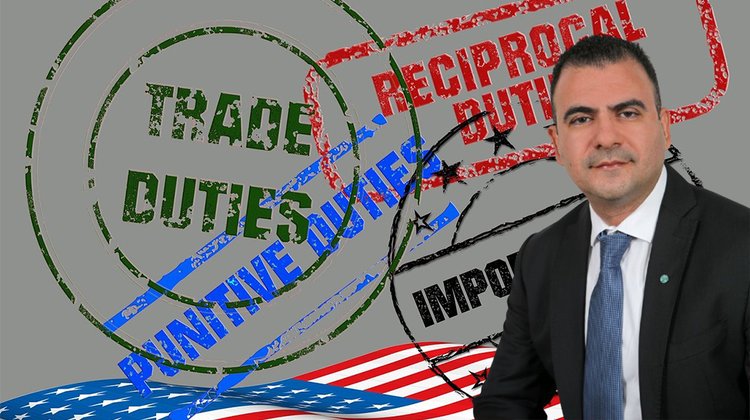Tariffs and Competitiveness: Who wins and who loses?
Constantinos Kourouyiannis 09:06 - 15 April 2025

On 2 April, 2025—what he called "Liberation Day"—US President Donald Trump announced sweeping tariffs on nearly all his country's trading partners.
His aim was to eliminate the US trade deficit, which he viewed as a transfer of wealth abroad. However, this move has been described as one of the largest and most unnecessary economic mistakes in modern global history, as it led to a collapse in international trade and a surge in protectionism.
Let’s explore what tariffs are, how they affect domestic producers and consumers, and what impact they have on competitiveness, international trade, and the broader economy.
What Are Tariffs?
Tariffs are taxes imposed by governments on imported goods. Their primary purpose is to protect local industries that produce the same or similar products and to reduce the trade deficit, that is, the gap between a country’s exports and imports when it is negative. At the same time, tariffs reduce demand for imported goods by raising their prices.
How Are Domestic Producers Affected?
Domestic producers may benefit from tariffs, as imported goods become more expensive and less competitive. This can lead to increased demand for local products, as consumers turn to cheaper alternatives. In turn, this rising demand may result in new investments, job creation, and the growth of industrial or agricultural sectors.
However, tariffs can also negatively impact domestic producers who export their products to other countries, particularly if those countries retaliate with their own tariffs. Furthermore, local producers can be harmed even by their own country’s tariffs, especially when they rely on imported intermediate goods or raw materials, since their production costs increase.
How Are Consumers Affected?
It’s typically consumers who suffer the most from tariffs. The increased cost of imported goods is passed on to them, meaning they pay more for the same products. Price hikes can be even more pronounced when tariffs are imposed on raw materials or intermediate goods like metals, semiconductors, and agricultural products, leading to even harsher consequences for consumers.
Tariffs also reduce the variety of imported products, limiting consumers’ options in terms of both quality and price. Additionally, tariffs may negatively affect product quality, as local producers have fewer incentives to improve their goods due to reduced competition.
Horizontal vs. Targeted Tariffs
There are two main types of tariffs, both of which we’ve experienced in recent years: horizontal tariffs, applied to all imports from one or more countries, and targeted tariffs, which focus on specific products or sectors. Horizontal tariffs are generally less effective, place a heavier burden on consumers, and may be more damaging to the wider economy. Targeted tariffs, on the other hand, can protect sensitive sectors and act as an effective tool of trade policy, especially in cases of unfair competition.
A representative example of targeted tariffs aimed at protecting the European auto industry is the European Union’s tariffs on Chinese electric vehicles. The decision followed an EU investigation that found Chinese firms such as BYD, NIO, and XPeng receive significant state subsidies, enabling them to sell their vehicles in Europe at very low prices, sometimes even below production costs (a practice known as dumping). As a result, on July 5, 2024, the EU imposed additional tariffs on Chinese electric vehicles, on top of the existing 10% import duty. These new tariffs vary by company, depending on the findings of the investigation.
This approach by the EU contrasts sharply with the decision made by the US President on April 2, 2025, to impose sweeping tariffs on almost all American trading partners. As a result, not only are consumers likely to suffer, facing fewer and more expensive options, but also producers, who may face rising input costs due to the increased price of raw materials.
Unsurprisingly, The Economist, one of the world’s most respected financial publications, named April 2, 2025, "Ruination Day", a stark contrast to Trump’s chosen term "Liberation Day." According to The Economist, the announcement of these broad tariffs signaled the collapse of global trade norms and the reinforcement of protectionist policies.
How Might Trade Partners React?
The response of trade partners is crucial and could vary. If they retaliate with their own tariffs, as China did, the consequences could be even more severe, especially if this leads to a spiral of trade retaliation. A wiser, more constructive response would be for America’s trade partners to collaborate among themselves, enhancing the trade rules that govern their mutual relationships.
A key question is whether China should be included in such efforts. On one hand, the EU has accused it of engaging in unfair competition through state subsidies. On the other hand, China could offer technological expertise and invest in European production facilities in exchange for lower tariffs.
Yet regardless of the eventual outcome of this trade war, one thing seems certain: the US economy is likely to weaken. America’s trading partners will not view it as a reliable trading partner going forward. For this reason, economic analysts have increased the probability that the US economy could slip into recession.
Notably, US government bond yields have risen (i.e., prices have dropped) following the tariff announcement, an unusual development, as such assets typically gain value during times of market uncertainty. This is a strong signal that markets do not believe these tariffs will achieve their stated goal of reducing the US trade deficit and, by extension, its national debt, but rather that they will likely produce the opposite effect.
*Constantinos Kourouyiannis, Vice President, CFA Society Cyprus
